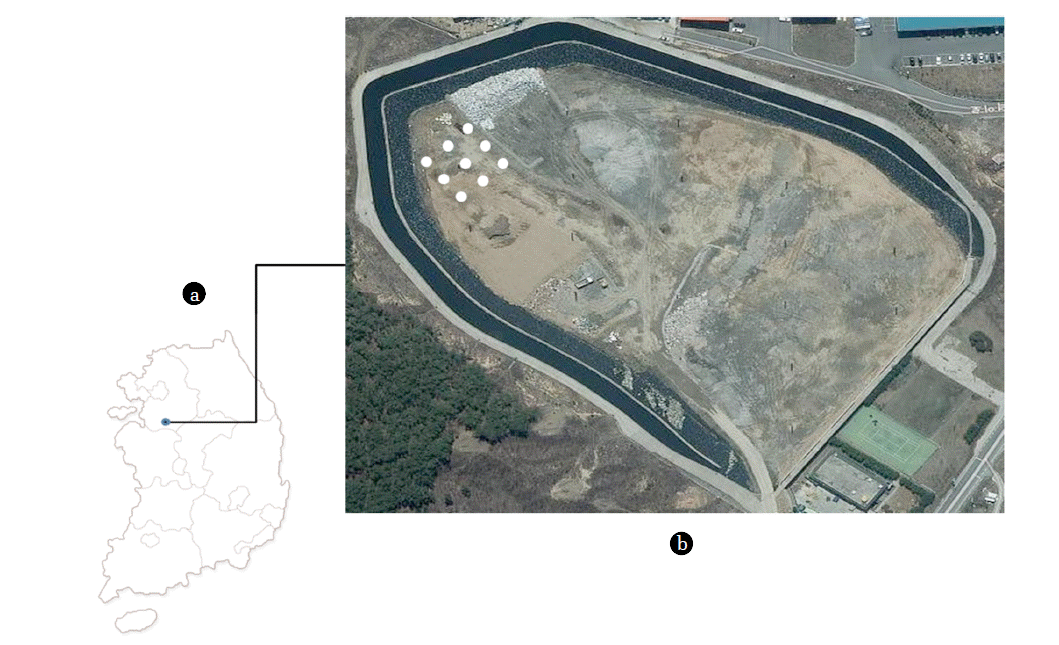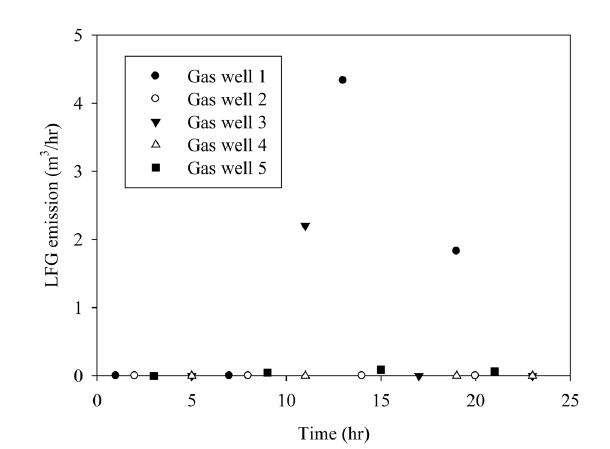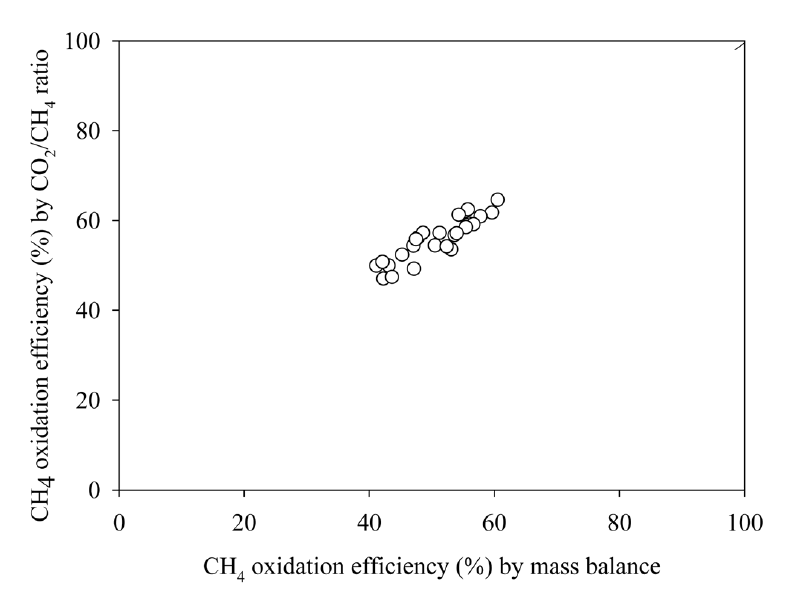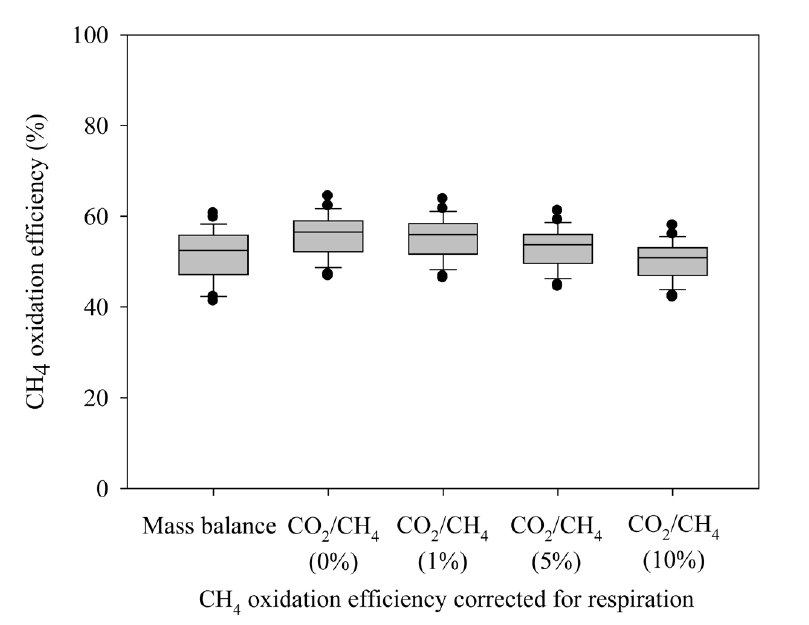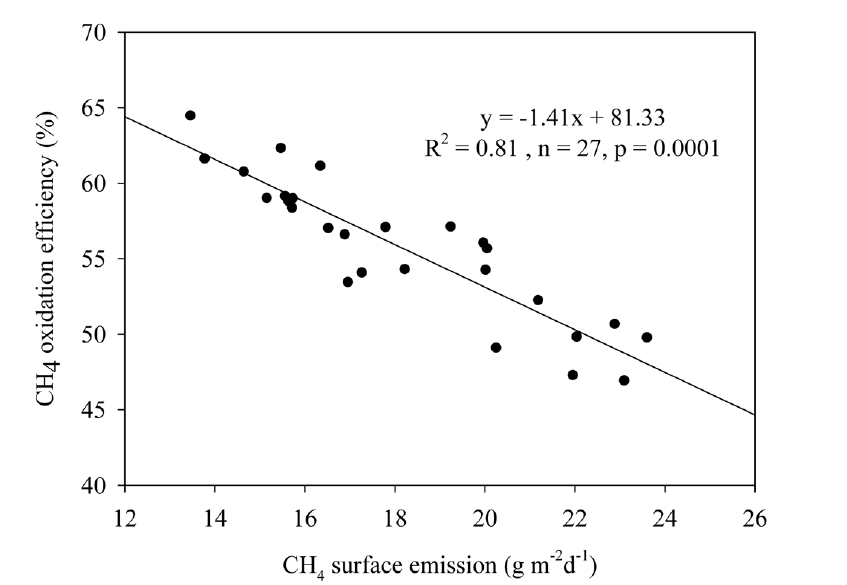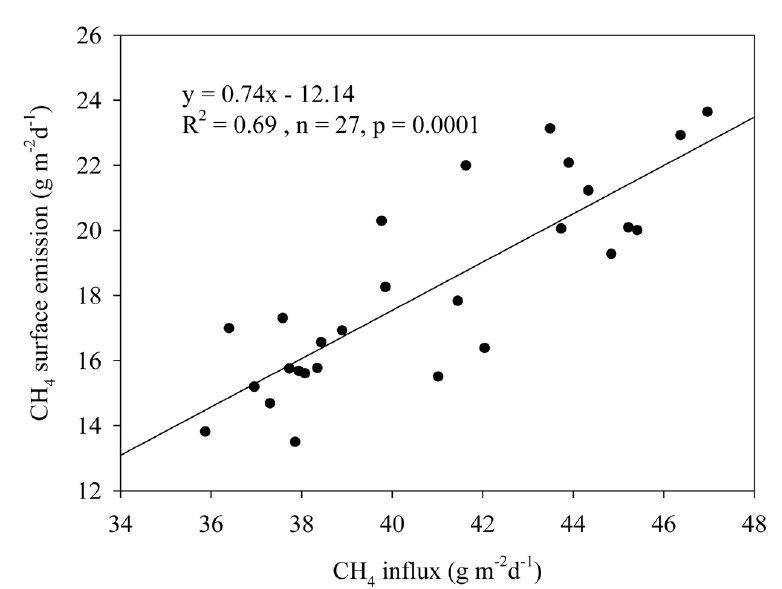1. Introduction
A significant source of CH4 production landfills have historically been considered the largest atmospheric CH4 emitter that represents 50–57% of global CH4 emissions that come from the waste sector [1].
CH4 oxidation is a natural process that takes place in soil systems without human interference, due to methanotrophic bacteria [2]. Replicating this natural process, landfill cover soil is used to facilitate the microbial oxidation of CH4 in order to help mitigate CH4 fluxes into the atmosphere. CH4 oxidation is considered a cost-effective technology to reduce CH4 emissions from landfills where a gas collection system has not been installed or is not economically feasible [3].
While much research has been conducted on CH4 oxidation efficiency [4–7], there continues to be insufficient information due to the lack of a standard method for measuring the process [2].
Several field measurement methods are currently available to measure CH4 oxidation efficiency including using carbon isotopes, mass balance, and CO2/CH4 methods. The carbon isotope measurement is currently the most precise method available for determining CH4 oxidation in landfill covers [8]. However, the carbon isotope method will underestimate the CH4 oxidation efficiency in landfill cover soils as well as the high cost of analysis because the isotope method underestimates the importance of molecular diffusion during gas transport [9].
An alternative method that has been used recently to estimate the CH4 oxidation is the mass balance, which could be used to estimate the CH4 oxidation using the difference between the CH4 flux at the top and at the bottom of landfill cover soil [10]. The bottom CH4 fluxes could be calculated by using a ratio of CH4 to CO2 at the bottom of a landfill cover. The mass balance method was validated by previous literatures [10–12].
Gebert et al. [11] have recently employed an alternative CO2/CH4 ratio method to measure the CH4 oxidation in landfill soils based on laboratory experiments. In addition, Pratt et al. [13] demonstrated a strong correlation between CH4 oxidation efficiency determined by mass balance and the CO2/CH4 ratio for a pumice landfill cover soil. Therefore, the ease and low cost of the CO2/CH4 ratio method is an attractive approach for landfill operators [13].
While the CO2/CH4 ratio method is a simple and inexpensive tool, further study is needed to validate the effectiveness of the CO2/CH4 ratio method in actual landfill sites; so far these authors [11, 13] have only assessed the effectiveness of the CO2/CH4 ratio method based on laboratory experiments.
Thus, the first objective of this study was to discuss the applicability of the CO2/CH4 ratio method in order to estimate CH4 oxidation efficiency. To achieve this objective, a comparison between the CO2/CH4 ratio and the mass balance methods was conducted. The second objective of this study was to estimate CH4 oxidation efficiency in an interim landfill soil and assess how CH4 influx influences the CH4 oxidation efficiency.
2. Materials and Methods
2.1. Site Description
The study was conducted at a sanitary landfill in Anseong City, Korea (Fig. 1). The annual mean temperature at the city ranges from 12 to 13°C. The annual precipitation is 1,100 mm yr−1. Since 2003, municipal waste, commercial waste, and bottom ash have been disposed of at this landfill. It covers an overall volume of about 568,200 m3 (38,200 m2), although only about 112,800 m3 is currently landfilled for municipal solid waste (MSW), which consist of approximately 10% paper, 10% plastic, 10% wood, 5% rubber, 2% others, and non-combustible 63% by wet weight. Currently, temporary landfill cover soil, consisting of 1 m sandy-clay loam material, limits surface CH4 emissions. No final cover caps have been installed in any part of the landfill. Seventeen vertical wells in the landfill were installed in a grid pattern and the landfill gas (LFG) collected through the vertical wells was emitted into the atmosphere.
In this study, three field campaigns to measure CH4 oxidation efficiencies were performed: on October 2, 2014, October 17, 2014, and November 11, 2014. The average precipitation in October and November was 119.5 mm and 24.9 mm, respectively (Korea Meteorological Administration, 2014). Measurements have been conducted in the day time (10 a.m.–6 p.m.).
2.2. CH4 Oxidation Efficiency
2.2.1. CO2/CH4 ratio method
CH4 oxidation efficiency was determined using the CO2/CH4 ratio. The CO2/CH4 ratio is based on the comparison of the CO2/CH4 ratio in the surface soil with that in the LFG (Fig. 2). It was assumed that CO2 is produced by oxidation of CH4 only, and that 1 mol of CH4 is converted to 1 mol of CO2 as a result of the oxidation process [11]. Therefore, the CH4 oxidation efficiencies could be calculated using the following equations [11, 13]:
where X is the portion of oxidized CH4 (vol.%), CH4LFG is the CH4 concentration of the LFG (vol.%), CO2LFG is the CO2 concentration of the LFG (vol.%), CH4d is the CH4 concentration on surface soil (vol.%) and CO2d is the CO2 concentration on surface soil (vol.%).
In order to analyze CH4 and CO2 concentrations, gas samples were collected at the site using chambers (0.012 m3). The gas samples were collected after 1 hour so that the effects of air dilution were minimized [13]. CH4 concentration was measured using a portable laser methane detector (LMD, Tokyo Gas Engineering). The LMD is a hand-held gas detector used for remote measurements of column density of methane-containing gases. The LMD can detect CH4 concentrations between 10 and 10,000 ppmv and up to a distance of 150 m. Precision of analysis for LMD was checked against a gas chromatography (Younglin 6000M, Korea) using a TCD. The CH4 concentration is calculated according to Eq. (3):
where M is the path-integrated CH4 concentration (ppmv·m), and X is the distance (m).
CO2 concentrations were measured by GC/TCD (Younglin 6000M, Korea). GC analysis conditions included setting the oven temperature at 35°C and the TCD filaments at 120°C. The carrier gas was helium running at a flow rate of 50 mL/min.
2.2.2. Mass balance method
The CO2/CH4 ratio method was compared to the mass balance method. The calculation is based on the assumption that all the CO2 is either already present in the system or results from CH4 oxidation. CH4 oxidation efficiency is defined by [10, 12]:
where FCH4 influx is the CH4 flux under the cover, and FCH4 surface flux is the CH4 flux measured at the ground level in the landfill. FCH4 influx is defined by:
where CH4 under the cover is the CH4 concentration under the landfill cover soil, and CO2 under the cover is the CO2 concentration under the landfill cover soil.
CH4 and CO2 surface fluxes were measured at the site using static chambers (with a diameter of 0.2 m and height of 0.4 m). Chambers were placed in a grid pattern; they were placed 10 m apart within a 20 m × 20 m section (Fig. 1). In order to collect gas samples for CO2 concentration analysis, a sampling port was placed on each chamber. Gas samples (10 mL) were drawn from each chamber three times over the course of one hour. CH4 concentrations were measured with the LMD. Linear increases in CH4 and CO2 concentrations in the chambers and CH4 and CO2 surface fluxes were calculated using Eq. (6) as follows:
where V is the volume of the chamber, A represents the area (m2) covered by the chamber, and dC/dt is the change in headspace CH4 and CO2 concentration with time (mg m−3 day−1).
3. Results and Discussion
3.1. Landfill Gas
Table 1 summarizes the change in CH4 and CO2 concentrations under the landfill soil cover. CH4 concentrations fluctuated between 7.2% and 8.1% at the site of the landfill containing mainly non-combustible waste, including ash. Environmental factors (soil types, moisture, pH, temperature, and air) can impact the rate of CH4 oxidation. Among these, methanotrophic activity is one of the crucial environmental factors in terms of dilution of CH4 concentrations. If the landfill cover soil is exposed to high CH4 concentration, it can develop a very high CH4 oxidation capacity. According to Wang et al. [14], CH4 oxidation rates in landfill soil were enhanced within a CH4 concentration range of 0.01–10% (v/v), while they remained stable within a range of 10–30% (v/v). Chi et al. [15] showed that the rate of CH4 oxidation efficiency sharply increases with the initial CH4 concentration because CH4 is the sole carbon substrate in all metabolic pathways.
Therefore, in the case of a landfill containing a high proportion of non-combustible waste, adjusting the gas wells may be a very effective way to increase the CH4 concentration in the LFG, leading to enhanced CH4 oxidation efficiency.
Seventeen vertical wells in the landfill were installed in a grid pattern. Fig. 3 presents LFG emission of five gas wells measured by an air velocity meter (TSI 8330-M-GB, USA) on October 2. The LFG emission at the gas wells was observed to vary from 0.0 to 4.3 m3 hr−1. The LFG emission of gas wells 2 and 4 was measured at zero. CH4 concentrations in the gas wells ranged from 0.0% to 2.2%. The occurrence of low LFG emission through the gas wells suggests that some gas wells in the landfill should be closed in order to increase CH4 concentrations, resulting in an enhanced CH4 oxidation efficiency.
3.2. Comparison Between CO2/CH4 Ratio and Mass Balance Methods
Fig. 4 shows a comparison between CH4 oxidation efficiencies obtained from a mass balance and the CO2/CH4 ratio calculations. CH4 oxidation efficiencies obtained through the CO2/CH4 ratio method are similar to those obtained through the mass balance method. However, the CO2/CH4 ratio method slightly overestimates the oxidation efficiencies compared to the mass balance method. It seems that the observed overestimation is affected by the respiration of landfill soil. The landfill cover soil respires, releasing CO2, resulting in a higher CO2/CH4 ratio and an overestimation of oxidation [11]. Huber-Humer et al. [8] noted that the interference resulting from landfill cover soil respiration should be factored in the methods adapted from the CO2/CH4 ratios.
However, this factor is unlikely to be a concern because CO2 generated by the oxidation of compounds is overshadowed by CH4 oxidation in soils [11, 13]. The proportion of CO2 produced by respiration is <10% at CH4 influxes above 12 g CH4 m−2 d−1 [13]. Moreover, in this study, the introduction of the correction for respiration in the vicinity of <10% led to a very close approximation of the estimated oxidation efficiency (Fig. 5). The results indicate that the carbon balance is dominated by CH4 oxidation. In this respect, the CO2/CH4 ratio method can be a reliable indicator of CH4 oxidation efficiency for landfill cover soils.
3.3. CH4 Oxidation Efficiency
As summarized in Table 2, CH4 oxidation efficiencies ranged between 46% and 64% for the CO2/CH4 ratios, and for the mass balance, it ranged between 41% and 62%. This research supports the evidence that the Intergovernmental Panel on Climate Change’s (IPCC) default value of 10% is an underestimation for landfill cover soils [16]. According to Börjesson et al. [6], the CH4 oxidation efficiencies for active landfill sites were estimated to range from 1.1% to 25.4% and those of closed landfill sites were observed to vary from 30.8% to 46.9%. Liptay et al. [17] reported 24–35% CH4 oxidation efficiency in the warm season. Chanton et al. [18] showed that CH4 oxidation efficiency was 33%, with a CH4 flux of 1 g m−2 d−1. In addition, Chanton et al. [19] measured the CH4 oxidation efficiency of 50%, where the CH4 flux was estimated at 20 g m−2 d−1. Therefore, further research is needed to estimate the CH4 oxidation efficiencies of landfill cover soils in order to develop country-specific parameters for Korea.
The higher CH4 oxidation efficiencies obtained in this study can be explained by the soil texture and layer thickness in addition to the low CH4 surface flux. The landfill surfaces in this study had been covered by an interim landfill cover soil consisting of a 1 m sandy-clay loam composite (pH 6.4), which provided sufficient oxygen. CH4 oxidation is positively linked to a sandy texture, indicating the dependence of CH4 oxidation on gas permeability [20]. According to Kightley et al. [21], the CH4 oxidation efficiencies for coarse sand and fine sand were 61% and 41%, respectively. Chanton et al. [18] summarized that the mean value for CH4 oxidation efficiency for differing soil covers ranged from 22% for clay to 55% for sand.
Moreover, using a soil layer thickness of more than 50 cm for CH4 oxidation can increase oxidation, particularly at low temperatures [22]. A thicker layer may also allow a higher CH4 oxidation rate because temperature and moisture may be more suitable and remain stable than in a thin cover. According to Albanna et al. [23], increasing the soil layer thickness from 15 to 20 cm increased CH4 oxidation efficiencies from 29% to 35%.
3.4. Influence of CH4 Influx on CH4 Oxidation Efficiency
CH4 oxidation efficiency is a function of cover type, climatic conditions, and CH4 influx to the bottom of the cover. The correlation between CH4 surface emissions and CH4 oxidation efficiency is shown in Fig. 6. The data were modeled using a linear function, and the resulting correlation coefficients (R2) of the linear regression were 0.81. The results show a negative linear relationship between the CH4 surface emissions and the CH4 oxidation efficiencies. Chanton et al. [19] have demonstrated that CH4 oxidation efficiency would be greatest at sites of low CH4 emissions and would decrease as CH4 emissions increased. According to Visscher and Cleemput [24], a high CH4 oxidation efficiency is obtained at CH4 fluxes up to 50 g m−2 d−1.
The correlation between CH4 surface emissions and CH4 influxes is shown in Fig. 7. CH4 surface emissions were observed to increase with increases in CH4 influx. This result shows a positive linear relationship between CH4 influxes and CH4 surface emissions. Assuming that gas pressure below the landfill cover remains consistent, atmospheric pressure can lead to a variation in CH4 surface emission. Czepiel et al. [25] reported that CH4 surface emissions decrease with an increase in atmospheric pressure. When atmospheric pressure increases, CH4 influx below the landfill cover decreases, resulting in oxygen diffusion from the upper boundary, thus increasing the amount of CH4 that can be oxidized. According to Berger et al. [26], oxygen is one of the most important limiting factors in the CH4 oxidation process and CH4 oxidation efficiency is a decreasing exponential function of the CH4 influx rate into the bottom of the cover. Thus, increasing CH4 influx to a landfill soil cover can reduce the CH4 oxidation efficiency. Pratt et al. [13] estimated that CH4 oxidation efficiency was 84% with a CH4 influx of 6 g m−2 d−1, whereas CH4 oxidation efficiency was 55% with a CH4 influx of 36 g m−2.
Therefore, CH4 influx under a landfill cover soil should be limited, in order to enhance CH4 oxidation efficiency. In the case of a landfill containing a high proportion of organic waste, including food waste, a gas collection system can be a very effective way to limit CH4 influx reaching the cover [19]. Because CH4 influxes in a landfill can be limited by a gas collection system, CH4 oxidation efficiency will be greater in those landfills with gas collection than in those without [19].
4. Conclusions
Precise and reliable measurements of CH4 oxidation efficiency in landfill soils are needed to develop country-specific parameters as used in the first order decay model of 2006 IPCC guidelines [16]. In addition, the reduction of LFG emissions could be applied to carbon emission cap and trading schemes, representing potential financial benefits for landfill operators [8].
In this study, CH4 oxidation efficiencies were determined by the mass balance and CO2/CH4 ratio methods. Despite CO2 respiration challenges, CH4 oxidation efficiencies obtained by the CO2/CH4 ratio method led to similar results to the mass balance method. As such, the CO2/CH4 ratio method could be successfully used to establish CH4 oxidation efficiency for landfill cover soil. Nevertheless, environmental factors (soil types, moisture, and CH4 concentration) for CH4 oxidation efficiencies still need to be studied for precise estimation.
The CH4 oxidation efficiencies obtained through the CO2/CH4 ratio in this study ranged between 46% and 64%, and the ones obtained through the mass balance method ranged between 41% and 62%. The results support the fact that the IPCC default value of 10% is an underestimation for landfill cover soils.
As expected, CH4 oxidation efficiency tended to be negatively correlated to CH4 influx. When CH4 influxes are high in a landfill, therefore, using a gas collection system can reduce the CH4 influx that reaches the landfill cover soil, which can, thereby, improve CH4 oxidation efficiency. In contrast, when CH4 influxes and concentrations are too low in a landfill, adjusting the gas wells may be a very effective way to increase the CH4 concentration in LFG, leading to enhanced CH4 oxidation efficiency.







